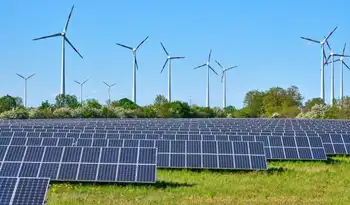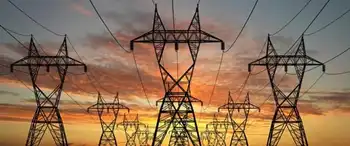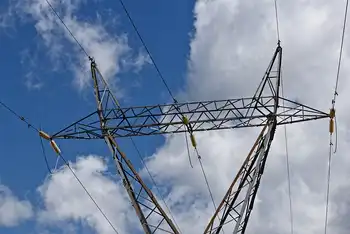Ameren offers mixed signals on system needs
ST. LOUIS, MISSOURI - For three years area utility customers have suffered through the cycle.
A storm leaves a massive power outage.
Ameren blames nature.
State regulators promise a thorough review but can't seem to say or do much to keep the lights on the next time.
And customers such as David Cohen are left in the dark - literally and figuratively.
"As far as what's going on in St. Louis, I haven't got a freakin' clue," said Cohen, of Maryland Heights.
No wonder he's confused.
As residents have endured four major outages since July 2004, a Post-Dispatch investigation has found that:
- Ameren executives insist publicly they've done all they can to limit storm outages but have told regulators in writing that they must spend more money on programs to boost reliability.
- Ameren has relied for years on tree trimmers to inspect the vast majority of the power grid - even though the trimmers' union says they lack training to spot many problems.
- Regulators in Missouri and Illinois have vastly different systems for ensuring utilities are reliable - with Missouri not yet making utilities regularly report basic outage measurements.
- Both Missouri and Illinois regulators have yet to hire outside engineers to investigate the outages, or boost standards and penalties for lax performance - unlike some states.
No one debates whether Ameren - or any other utility - can prevent storm outages. Even some of Ameren's harshest critics say such severe storms would batter any utility's power grid.
What is debated is whether Ameren skimped on its network of poles, wires and other hardware that delivers power to homes and businesses, and if that worsened the scope or length of the outages.
Ameren executives insist that's not the case. They say they've heavily invested in the power grid, and they note that other utilities across the country have seen major outages after storms - such as the one million left without power in Washington state.
Missouri and Illinois regulators aren't convinced the utility bears no blame. Missouri's Public Service Commission has given Ameren a month to deliver fresh solutions to stop the cycle. To help cull ideas, utility executives pledged to hire an outside expert.
But, for now, they're stumped.
"We really have been over this so many times," said Ameren's chief executive officer, Gary Rainwater. "It will be difficult for us to come up with anything new in 30 days."
A host of elected leaders and regulators are willing to fill any void of ideas.
Roy Buxton doesn't mince words about how well he thinks Ameren inspects the vast majority of its poles, equipment and wires.
"They don't have a distribution inspection program of any kind," he said.
Buxton is a longtime engineer with the Illinois Commerce Commission, the state's regulator of utilities. The commission learned in 2004 that Ameren relied on tree trimmers working for contractors to do visual inspections to catch any problems in the utility's distribution lines.
The commission demanded that Ameren beef up its inspections.
"Tree trimmers are not circuit inspectors," Buxton said. "And if that's not bad enough, they only go where the trees are."
There's agreement from the St. Louis tree trimmers' union - Local 2 of the International Brotherhood of Electrical Workers. Union officers complain their members lack the training or the time to properly inspect the lines.
"They're trained to do the trees," said the local's business manager, Dave Desmond. "They're not trained to look at the line to tell them what's wrong with it."
Buxton's peers at the Missouri Public Service Commission haven't demanded changes to the inspection program - at least yet. The commission's staff found that other utilities use similar tree- trimming programs, although the staff wants Ameren to consider improvements.
Ameren said the program worked fine.
"We think it's a very effective program, because they (tree trimmers) are there on a regular basis, and they find things that do need to be corrected," said Tom Voss, Ameren's executive vice president and chief operating officer.
Yet in regulatory filings in Missouri two weeks before the summer storms, Ameren's senior vice president of Missouri energy delivery, Richard Mark, said the utility needed to boost spending on inspections.
He testified that "recent studies" convinced the utility of the need to quadruple spending on a special pole inspection program in place for bigger feeder lines in the transmission and subtransmission system, which carries power from plants into the substations and feeders. They want to expand that inspection program to include the distribution system's smaller lines and poles that deliver power to customers.
Mark's testimony was part of Ameren's effort to persuade Missouri regulators to boost electric rates, which have fallen 13 percent since the last increase in 1987. To get rates increased, Ameren must convince the regulators it needs the cash for good reason.
"By replacing poles prior to failure, AmerenUE expects to avoid outages, reduce the scale of outages which do occur and reduce the restoration time of those outages," Mark testified to the Missouri commission in July.
The utility confirmed that it was pursuing the program, in part, to address the concerns of Illinois and Missouri regulators.
Still, Mark said that it would be unfair to imply that Ameren's distribution network was inadequate just because the utility wanted to make improvements. Rather, the utility is evolving its services "to the needs of our customers in the 21st century."
"To do that, we have to implement new programs that are going to take us to a better level of reliability," he said.
In public, Ameren has played down questions about whether better inspections and equipment replacement would have limited, in any way, outages from the storms.
Rainwater was asked in July whether any weakness in a pole or other equipment could make the difference between them staying up in a storm or toppling. He put the odds at "one in a million" that it would make a difference, and said besides, Ameren heavily invests in its grid to meet industry quality standards.
Still, it's difficult to determine just how much a utility spends on its distribution system.
Take AmerenUE, the Missouri affiliate. AmerenUE officials say they've boosted spending on their distribution system in Missouri by more than 31 percent in five years, but it's difficult to confirm that through regulatory filings.
Federal regulatory documents suggest that AmerenUE's spending is actually flat, but the utility said the figures didn't include other money spent on the system, nor adjust for a loss of some territory in 2005.
Missouri regulators, meanwhile, show that AmerenUE's total spending on both its distribution and transmission system is up 10 percent since 2001 - keeping pace with inflation.
The figures mean little to customers who have lost faith with the company. One such customer is Jerry Eichholz. He spent seven months trying to get Ameren to address the cause of more than 25 outages his subdivision suffered since 2001, including the seven-day storm outage this summer.
Six weeks ago, he said, the utility trimmed trees in the area and upgraded equipment.
When the ice storm came, his power stayed on.
He doesn't think it's a coincidence.
"This is one of the few times in five years that when rain or a storm has come though that we did not have some sort of power interruption in our area," he said.
The debate continues with an issue that's long pitted Ameren against regulators in both states: tree trimming.
Whereas trimming won't prevent a majority of storm outages, regulators say it does help reduce the scope of them. And after the first major outage in 2004, regulators discovered Ameren had cut back funding for trimming and fallen behind schedule.
Missouri regulators forced Ameren to catch up by 2008. That's required utility executives to boost the trimming budget - even as they offer mixed signals on whether such work reduces storm outages.
In July, Rainwater said it was "simply wrong" to think trimming reduces outages from severe storms.
"It isn't like, well, it would make a little difference if you trimmed the trees a little better," he said. "It makes no difference at all - no difference whatsoever."
Yet in September, the utility's vice president of energy delivery-distribution, Ron Zdellar, pitched an idea to Missouri regulators to boost the tree-trimming program by 50 percent. Beyond wanting to target the removal of problematic trees off the utility's right-of- way, Ameren proposed trimming more from trees in easements and doing it more frequently for some lines.
Zdellar testified that the programs would specifically reduce storm damage.
"I would expect the scope of outages to be reduced, and restoration times should also be improved," he testified, "since there will be fewer vegetation-related problems on the circuits that go out of service during a storm."
The tree trimmers' union said there was no doubt that trimming limited outages, and union officials said the utility's conflicting positions reflected its broader hot-and-cold attitude toward trimming.
Rick Weirich, the line clearance representative for Local 2, said Ameren commonly pumped money into trimming only to cut back later. He points to Ameren's Nov. 17 elimination of funds for 18 crews of trimmers. That's about 10 percent of Local 2's 536 trimmers and other vegetation crew members who worked at the time for contractors hired by Ameren.
The cutback came the same day Missouri regulators issued their draft report of their investigation of the summer outage. A key recommendation: Ameren should expand its tree-trimming efforts.
"It's crazy," he said. "Just a couple weekends before, around the first of November, we were working Saturdays and looking for people."
Ameren, however, plays down the significance of the cuts. Spokeswoman Susan Gallagher said that even with the cuts, the company still has 10 percent more trimmers working now than in January, and that doesn't count additional trimmers brought in for storm restoration and cleanup.
She also said that hiring cycles were natural to a trimming program that must juggle different types of jobs and workloads, and that Ameren would rehire the crews within the next month.
"There's always ebb and flow in the number of people doing the work," she said.
Ameren also said its program remained on pace to meet the 2008 target while maintaining quality standards.
But Weirich questions the quality. He claims that Ameren "rides these (trimming) companies so hard" to cover large territories, leaving the trimmers unable to do thorough work, and contributing to outages.
"You're getting quantity (of trimming), but you're not getting quality," he said.
In filings with Missouri regulators, Ameren has also touted a program to add special equipment to limit outages.
Called tap fuses, the devices help keep outages at one end of a circuit from taking down the entire circuit. It's part of a broader program - called sectionalization - utilities are increasingly using to isolate outages. The concept is similar to a house's fuse box. If the bathroom lights trip a circuit breaker, only the bathroom - not the whole house - goes dark.
But there are no standards across the country for how much sectionalization equipment a utility should install. At best, utilities base reliability on indexes that measure the length and duration of outages. Engineers then pore through the data, find problem circuits and find ways to sectionalize those circuits.
But there's a catch. In measuring reliability, Ameren and other utilities commonly exclude any data from major outages caused by severe storms. They argue that it'd be a waste of money to study such infrequent and unusual power losses.
That means St. Louis areas that are repeatedly hit with long storm outages - but that somehow avoid the more mundane, minor outages - can get left out of sectionalization projects.
It's unclear just who gets left out.
As part of Missouri regulators' investigation into the summer storm outage, the utility provided studies showing the projects its engineers wanted to pursue. But Ameren stamped the studies "highly confidential." Missouri law allows the utility to do so if it believes the information contains trade secrets that shouldn't be seen by the public.
Regardless, Warren Wood, the commission's head of utility operations, cautioned that sectionalization projects might not be very effective in limiting widespread storm outages because of damage that could occur at different points in the same circuit.
But experts say it's still worth studying. Among them is Mike Rafferty, an engineer who focuses on utility reliability studies with the Florida consulting firm Williams Consulting Inc.
"You look at it both ways - what impact it can have for non- excluded events, and what impact for storms. Clearly it can have an impact in both," he said.
The reliability measurements do, however, help regulators know where to look for problems - if they regularly collect reliability data.
Missouri doesn't. The commission's staff has proposed a rule doing so, but it remains in limbo.
Compare that with Illinois, where lawmakers have mandated that regulators assess each utility's reliability every three years. In doing so, the Illinois Commerce Commission staffers analyze data on outages provided by the utilities to figure out which circuits are the worst. Engineers such as Buxton then walk the circuits looking for problems.
They compile the information in thick reports - posted for the public on their Internet site - complete with color photos and specific logs of problems found, from rotted poles to overgrown trees. Those reports also contain broader complaints by the state engineers, such as lack of tree trimming or circuit inspection.
In Missouri, for now, the public's glimpse into utility's problems often comes only after regulators investigate a major outage.
Utility officials say the differences in reporting requirements don't affect storm outages - pointing to this month's ice outage that hit Illinois at least as hard as Missouri.
Still, it leaves people such as Cohen frustrated. He spent four days without power this summer, and in the three months prior, he said, he had two other outages significant enough to force his family into a hotel.
"There has to be some way to shake some answers lose from these (utility) people," Cohen said. "They have a responsibility. They have to be held accountable."
Some Missouri Public Service commissioners - who ultimately set policy - are considering pushing for the state to join a growing list of states with precise standards and penalties for utilities that don't make the grade.
"We're nowhere near where we need to be in terms of standards, and it's very disturbing," Commissioner Steve Gaw told his peers in a recent hearing in Jefferson City.
Added the commission's chairman, Jeff Davis: "We don't have any standards at all."
After a snowstorm in 2003 left 190,000 people in Utah powerless for up to five days, regulators there did something neither Illinois nor Missouri has done for any of Ameren's outages: Utah hired outside engineers to oversee its investigation.
Utah Power eventually released a 300-page report outlining 28 recommendations it felt it had to do to improve. The outside engineers, Williams Consulting, added 18 more - all of which were eventually adopted.
The utility also did something Ameren has yet to do for any of its storm outages: Utah Power, at the request of regulators, refunded $1.9 million worth of utility bills to 14,000 customers who suffered the longest outages.
Utah Power called them "goodwill" payments.
In other places, consulting firms have done forensic testing to see how well utilities equipment held up in storms. That helped Florida regulators determine that many poles that snapped in one recent hurricane were weak from rot - resulting in new standards requiring pole inspections every eight years.
At least three Missouri commissioners say they'd support hiring an outside consulting firm to investigate Ameren, if the money can be found. Williams Consulting's fee in Utah was $32,000.
Commissioners also say their staff is already overworked trying to keep pace with requests for rate increases from utilities around the state.
And, commissioners say, they want a more aggressive look at Ameren. They're already questioning if the commission staff's draft report of the summer outage was thorough enough and demanded enough of Ameren.
"I'm very concerned that we didn't ask all the questions - that we didn't ask, in some cases, the right questions," Davis said.
Commissioner Robert Clayton said he accepted the criticism of some customers who felt the commission hadn't done enough itself.
"I think we have to take that blame, and that's why our response now needs to be stronger," he said.
Said Davis: "We have to do better. That's the bottom line."
Related News

Should California Fund Biofuels or Electric Vehicles?
CALIFORNIA - California is at the forefront of the transition to a greener economy, driven by its ambitious goals to reduce greenhouse gas emissions and combat climate change. As part of its strategy, the state is grappling with the question of whether it should subsidize out-of-state biofuels or in-state electric vehicles (EVs) to meet these goals. Both options come with their own sets of benefits and challenges, and the decision carries significant implications for the state’s environmental, economic, and energy landscapes.
The Case for Biofuels
Biofuels have long been promoted as a cleaner alternative to traditional fossil fuels like gasoline…




